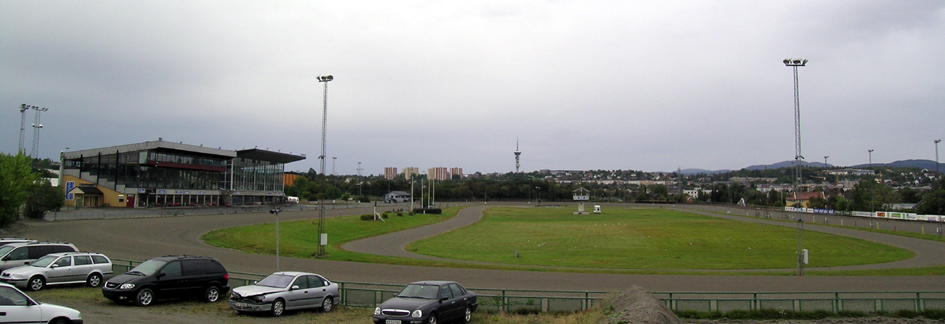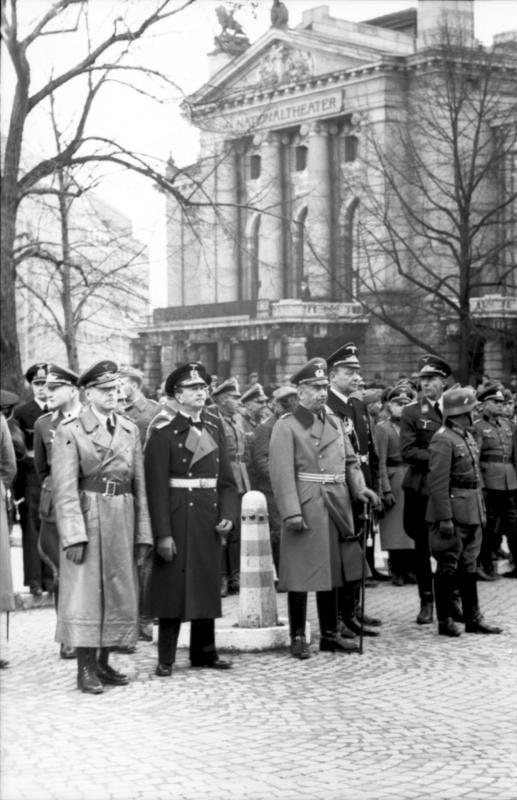|
Leangen Travbane
Leangen Travbane is a harness racing course located at Leangen in Trondheim, Norway. The race course is owned by the Norwegian Trotting Association and its parimutuel betting is handled by Norsk Rikstoto. Through this arrangement it is the only equine tote betting establishment in Trøndelag and Møre og Romsdal. History was established as the first horse racing club in Norway in 1873, and the first club in Trondheim, , was established in 1879, with Johan Henrik Spørck as the most enthusiastic founder. He took initiative for the first organized race to be held on the ice of Jonsvatnet that winter, and paid 200 Norwegian krone (NOK) in prize money from his own pocket. Summer races were organized along the closed off section of the Trondhjem–Støren Line, which had been closed between Sluppen and Valset. The organization worked with the breeding of fast trotting horses, and based itself on the Dølahest. Interest declined from 1895, but rose again from 1904, when Trø ... [...More Info...] [...Related Items...] OR: [Wikipedia] [Google] [Baidu] |
Leangen Trotting Track Trondheim
Leangen is a largely industrial neighborhood in the city of Trondheim in Trøndelag county, Norway. It is located in the borough of Østbyen. It is the site of the Leangen Sports Complex (''Leangen idrettsanlegg'') which includes an indoor ice hockey arena Leangen Ice Hall Leangen Ishall is an indoor ice hockey arena located in Leangen, Trondheim, Norway. The capacity of the arena is 3,000 and it was opened in 1977. It is the home arena of the Nidaros ice hockey team. The arena also hosted the home games of the Tron ... (''Leangen Ishall'') and Leangen Sports Hall (''Leangen idrettshall'') an indoor running track and training facility. Leangen is also the location of Leangen Racecourse (''Leangen Travbane''), a harness racing course as well as a facility of Sør-Trøndelag University College. References External linksLeangen Travbane website Geography of Trondheim Neighbourhoods of Trondheim {{Trøndelag-geo-stub ... [...More Info...] [...Related Items...] OR: [Wikipedia] [Google] [Baidu] |
Leangen
Leangen is a largely industrial neighborhood in the city of Trondheim in Trøndelag county, Norway. It is located in the borough of Østbyen. It is the site of the Leangen Sports Complex (''Leangen idrettsanlegg'') which includes an indoor ice hockey arena Leangen Ice Hall (''Leangen Ishall'') and Leangen Sports Hall (''Leangen idrettshall'') an indoor running track and training facility. Leangen is also the location of Leangen Travbane, Leangen Racecourse (''Leangen Travbane''), a harness racing course as well as a facility of Sør-Trøndelag University College. References External linksLeangen Travbane website Geography of Trondheim Neighbourhoods of Trondheim {{Trøndelag-geo-stub ... [...More Info...] [...Related Items...] OR: [Wikipedia] [Google] [Baidu] |
Sports Venues In Trondheim
Sport pertains to any form of competitive physical activity or game that aims to use, maintain, or improve physical ability and skills while providing enjoyment to participants and, in some cases, entertainment to spectators. Sports can, through casual or organized participation, improve participants' physical health. Hundreds of sports exist, from those between single contestants, through to those with hundreds of simultaneous participants, either in teams or competing as individuals. In certain sports such as racing, many contestants may compete, simultaneously or consecutively, with one winner; in others, the contest (a ''match'') is between two sides, each attempting to exceed the other. Some sports allow a "tie" or "draw", in which there is no single winner; others provide tie-breaking methods to ensure one winner and one loser. A number of contests may be arranged in a tournament producing a champion. Many sports leagues make an annual champion by arranging games in a ... [...More Info...] [...Related Items...] OR: [Wikipedia] [Google] [Baidu] |
Association Football
Association football, more commonly known as football or soccer, is a team sport played between two teams of 11 players who primarily use their feet to propel the ball around a rectangular field called a pitch. The objective of the game is to score more goals than the opposition by moving the ball beyond the goal line into a rectangular framed goal defended by the opposing side. Traditionally, the game has been played over two 45 minute halves, for a total match time of 90 minutes. With an estimated 250 million players active in over 200 countries, it is considered the world's most popular sport. The game of association football is played in accordance with the Laws of the Game, a set of rules that has been in effect since 1863 with the International Football Association Board (IFAB) maintaining them since 1886. The game is played with a football that is in circumference. The two teams compete to get the ball into the other team's goal (between the posts and under t ... [...More Info...] [...Related Items...] OR: [Wikipedia] [Google] [Baidu] |
Wehrmacht
The ''Wehrmacht'' (, ) were the unified armed forces of Nazi Germany from 1935 to 1945. It consisted of the ''Heer'' (army), the ''Kriegsmarine'' (navy) and the ''Luftwaffe'' (air force). The designation "''Wehrmacht''" replaced the previously used term and was the manifestation of the Nazi regime's efforts to rearm Germany to a greater extent than the Treaty of Versailles permitted. After the Nazi rise to power in 1933, one of Adolf Hitler's most overt and audacious moves was to establish the ''Wehrmacht'', a modern offensively-capable armed force, fulfilling the Nazi régime's long-term goals of regaining lost territory as well as gaining new territory and dominating its neighbours. This required the reinstatement of conscription and massive investment and defense spending on the arms industry. The ''Wehrmacht'' formed the heart of Germany's politico-military power. In the early part of the Second World War, the ''Wehrmacht'' employed combined arms tactics (close-cover ... [...More Info...] [...Related Items...] OR: [Wikipedia] [Google] [Baidu] |
German Occupation Of Norway
The occupation of Norway by Nazi Germany during the Second World War began on 9 April 1940 after Operation Weserübung. Conventional armed resistance to the German invasion ended on 10 June 1940, and Nazi Germany controlled Norway until the capitulation of German forces in Europe on 8 May 1945. Throughout this period, a pro-German government named Den nasjonale regjering (English: the National Government) ruled Norway, while the Norwegian king Haakon VII and the prewar government escaped to London, where they formed a government in exile. Civil rule was effectively assumed by the ''Reichskommissariat Norwegen'' (Reich Commissariat of Norway), which acted in collaboration with the pro-German puppet government. This period of military occupation is, in Norway, referred to as the "war years", "occupation period" or simply "the war". Background Having maintained its neutrality during the First World War (1914–1918), Norwegian foreign and military policy since 1933 was largely ... [...More Info...] [...Related Items...] OR: [Wikipedia] [Google] [Baidu] |
Strinda
Strinda is a former municipality in the old Sør-Trøndelag county, Norway. The municipality existed from 1838 until its dissolution in 1964. The municipality encompassed the eastern part of what is now the municipality of Trondheim south and east of the main city center all the way southeast to the lake Jonsvatnet, and it originally included what is now the municipality of Malvik. The western part of the municipality was heavily urbanized, while the areas further east and south were more suburban. The administrative centre was actually located in the neighboring city of Trondheim, just across the Nidelva river on the ''Kjøpmansgata'' road. History The municipality of Strinda was established on 1 January 1838 (see formannskapsdistrikt). According to the 1835 census, Strinda had a population of 4,593. In 1891, the eastern parish of Malvik (population: 2,487) was separated from Strinda to form its own municipality, leaving Strinda with a population of 2,769. Starting in 1864, a ... [...More Info...] [...Related Items...] OR: [Wikipedia] [Google] [Baidu] |
Sverre S
Sverre, Sverrir or Sverri is a Nordic name from the Old Norse ''Sverrir'', meaning "wild, swinging, spinning". It is a common name in Norway, Iceland and the Faroe Islands; it is less common in Denmark and Sweden. It can also be a surname. Sverre may refer to: First name Sverre * Sverre of Norway (c. 1145/1151 – 9 March 1202) *Prince Sverre Magnus of Norway (born 3 December 2005) *Sverre Farstad, Norwegian speed skater *Sverre Fehn (1924–2009), Norwegian architect *Sverre Hassel, Norwegian *Sverre Anker Ousdal, Norwegian actor *Sverre Petterssen, Norwegian *Sverre Steen, Norwegian history professor *Sverre Stenersen, Norwegian *Sverre Seeberg, Norwegian Sverri *Sverri Sandberg Nielsen (born 1993) a Faroese rower *Sverri Patursson (1871–1960), a Faroese writer Sverrir *Sverrir Garðarsson, Icelandic *Sverrir Gudnason, Swedish *Sverrir Hermannsson, Icelandic Last name *Johan Sverre (actor) *Johan Sverre (sports official) Johan Tidemann Sverre (7 October 1867 – 6 June 1934) ... [...More Info...] [...Related Items...] OR: [Wikipedia] [Google] [Baidu] |
Warmblood
Warmbloods are a group of middle-weight horse types and breeds primarily originating in Europe and registered with organizations that are characterized by open studbook policy, studbook selection, and the aim of breeding for equestrian sport. The term distinguishes these horses from both heavy draft horses ("cold bloods") and refined light saddle horses such as the Thoroughbred, Arabian, and Akhal-Teke ("hot bloods"). Although modern warmbloods are descended from heavier agricultural types systematically upgraded by hotblood influence, the term does not imply that warmbloods are direct crosses of "cold" and "hot". Breeding policies Open studbook policies separate most warmbloods from true "breeds" such as Thoroughbreds, Arabians, Percherons, and Morgans which have a closed stud book and require two purebred parents. Instead, most warmblood registries accept breeding stock from other similar populations to continuously improve their own, and do not consider their own horses ... [...More Info...] [...Related Items...] OR: [Wikipedia] [Google] [Baidu] |
Oslo
Oslo ( , , or ; sma, Oslove) is the capital and most populous city of Norway. It constitutes both a county and a municipality. The municipality of Oslo had a population of in 2022, while the city's greater urban area had a population of in 2019, and the metropolitan area had an estimated population of in 2021. During the Viking Age the area was part of Viken. Oslo was founded as a city at the end of the Viking Age in 1040 under the name Ánslo, and established as a ''kaupstad'' or trading place in 1048 by Harald Hardrada. The city was elevated to a bishopric in 1070 and a capital under Haakon V of Norway around 1300. Personal unions with Denmark from 1397 to 1523 and again from 1536 to 1814 reduced its influence. After being destroyed by a fire in 1624, during the reign of King Christian IV, a new city was built closer to Akershus Fortress and named Christiania in honour of the king. It became a municipality ('' formannskapsdistrikt'') on 1 January 1838. The city fu ... [...More Info...] [...Related Items...] OR: [Wikipedia] [Google] [Baidu] |
Bjerke Travbane
Bjerke Travbane ( en, Bjerke Race Track) is a harness racing track located in the Bjerkebanen neighborhood of the Bjerke borough in Oslo, Norway. The course is . Owned by Norwegian Trotting Association, its tote betting is handled by Norsk Rikstoto. The venue opened in 1928 and is the busiest harness racetrack in Norway, with 115 racedays in 2012. Notable race * Oslo Grand Prix Oslo Grand Prix is an annual Group One harness event that takes place at Bjerke Racetrack in Oslo, Norway. The competition was inaugurated in 1966 and is regarded as Norway's biggest trotting event. It is raced over 2,100 meters and is part of t ... References External links Official website Sports venues in Oslo Harness racing venues in Norway Sports venues completed in 1928 1928 establishments in Norway {{Norway-sports-venue-stub ... [...More Info...] [...Related Items...] OR: [Wikipedia] [Google] [Baidu] |





